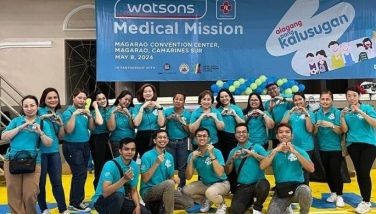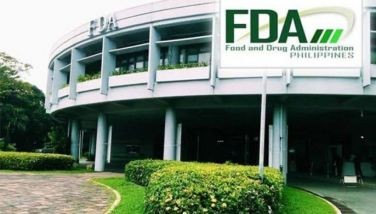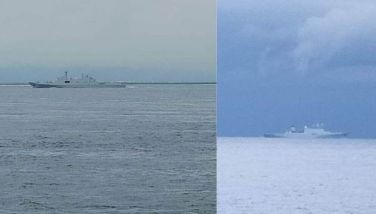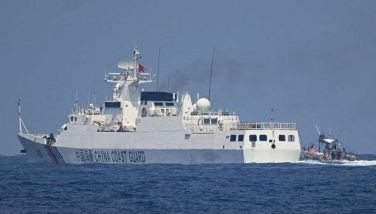Asian countries adopt RP-bred rice varieties
September 9, 2001 | 12:00am
LOS BAÑOS, Laguna – Some Asian countries are now planting rice varieties and breeding lines developed by the Philippines. Others are finally testing some of the RP-bred varieties and lines.
Executive Director Leocadio S. Sebastian of the Department of Agriculture-Philippine Rice Research Institute (DA-PhilRice) reported this development at the meeting of the International Network for the Genetic Evaluation of Rice (INGER) held recently in Bangkok, Thailand.
PhilRice being the national coordinator of INGER projects in the Philippines, Dr. Sebastian serves as a member of the INGER technical advisory committee. The International Rice Research Institute (IRRI) here hosts the INGER office.
During the Bangkok meeting, the INGER member-countries reported on how they used the genetic materials that other countries had shared with them.
Dr. Sebastian said that MRC19399-1224, a breeding line that PhilRice has shared in the INGER nursery, became a released variety in Vietnam named OMFi-I. Released in 1997, the variety is now planted in about 10,000 hectares of rice lands in Vietnam.
MRC19399-1224 was also released in the Philippines as PSB Rc8 (Talavera) in 1992, stated a PhilRice report prepared by Jennifer C. Jara-Rabara.
Two Philippine-released varieties for dry-seeded rain-fed ocosystem, namely: PSB Rc68 (Sacobia) and PSB Rc70 (Bamban), are also under final evaluation in Myanmar.
Since 1987 when PhilRice began operation (it was created in 1985), it and the PhilRice-coordinated national rice research and development network composed of 56 agencies and IRRI have bred 55 rice varieties, many of which are now widely planted in the country. Those that are intended for the irrigated lowlands are named after rivers (e.g., Magat, Rio Grande, Pasig, Chico, Pagsanjan) while those for the uplands are named after mountains (Makiling, Arayat, Banahaw).
Since 1985, two, of the 12,122 varieties and breeding lines that were shared by the INGER member-countries, 66 were from the Philippines. Likewise, since the Philippines began participating in INGER in 1982, PhilRice has been able to develop six PSB-approved rice varieties adapted to various ecosystems that have in their lineage or pedigree, lines selected from the INGER trials.
PSB stands for Philippine Seed Board, now National Seed Industry Council or NSIC. It is a government agency under the DA-Bureau of Plant Industry that approves the release of new plant varieties, including rice, for commercialization.
The six varieties are PSB Rc24 (Cagayan), Rc42 (Baliwag), both for rain-fed dry-seeded areas; PSB Rc56 (Dapitan), Rc66 (Agusan), both for irrigated lowland; PSB90 (Buguey), for saline-prone; and PSB Rc7 (Banahaw), for upland areas.
PhilRice has also nominated to INGER the institute’s eight rice lines. These PhilRice-developed lines are undergoing tests for grain quality and pest and disease resistance in INGER-member countries.
Dr. Sebastian said the INGER mechanism provides member-countries free access to rice germplasm and this significantly has increased rice genetic diversity in the Philippines. It has also enriched the country’s rice breeding program with diverse materials that are very useful in improving the genetic structure of Philippine rice varieties.
From the INGER nursery, member-countries are able to screen entries that would later become donor parents for resistance and grain quality, which help improve the quality of rice lines of INGER member-countries.
Executive Director Leocadio S. Sebastian of the Department of Agriculture-Philippine Rice Research Institute (DA-PhilRice) reported this development at the meeting of the International Network for the Genetic Evaluation of Rice (INGER) held recently in Bangkok, Thailand.
PhilRice being the national coordinator of INGER projects in the Philippines, Dr. Sebastian serves as a member of the INGER technical advisory committee. The International Rice Research Institute (IRRI) here hosts the INGER office.
During the Bangkok meeting, the INGER member-countries reported on how they used the genetic materials that other countries had shared with them.
Dr. Sebastian said that MRC19399-1224, a breeding line that PhilRice has shared in the INGER nursery, became a released variety in Vietnam named OMFi-I. Released in 1997, the variety is now planted in about 10,000 hectares of rice lands in Vietnam.
MRC19399-1224 was also released in the Philippines as PSB Rc8 (Talavera) in 1992, stated a PhilRice report prepared by Jennifer C. Jara-Rabara.
Two Philippine-released varieties for dry-seeded rain-fed ocosystem, namely: PSB Rc68 (Sacobia) and PSB Rc70 (Bamban), are also under final evaluation in Myanmar.
Since 1987 when PhilRice began operation (it was created in 1985), it and the PhilRice-coordinated national rice research and development network composed of 56 agencies and IRRI have bred 55 rice varieties, many of which are now widely planted in the country. Those that are intended for the irrigated lowlands are named after rivers (e.g., Magat, Rio Grande, Pasig, Chico, Pagsanjan) while those for the uplands are named after mountains (Makiling, Arayat, Banahaw).
Since 1985, two, of the 12,122 varieties and breeding lines that were shared by the INGER member-countries, 66 were from the Philippines. Likewise, since the Philippines began participating in INGER in 1982, PhilRice has been able to develop six PSB-approved rice varieties adapted to various ecosystems that have in their lineage or pedigree, lines selected from the INGER trials.
PSB stands for Philippine Seed Board, now National Seed Industry Council or NSIC. It is a government agency under the DA-Bureau of Plant Industry that approves the release of new plant varieties, including rice, for commercialization.
The six varieties are PSB Rc24 (Cagayan), Rc42 (Baliwag), both for rain-fed dry-seeded areas; PSB Rc56 (Dapitan), Rc66 (Agusan), both for irrigated lowland; PSB90 (Buguey), for saline-prone; and PSB Rc7 (Banahaw), for upland areas.
PhilRice has also nominated to INGER the institute’s eight rice lines. These PhilRice-developed lines are undergoing tests for grain quality and pest and disease resistance in INGER-member countries.
Dr. Sebastian said the INGER mechanism provides member-countries free access to rice germplasm and this significantly has increased rice genetic diversity in the Philippines. It has also enriched the country’s rice breeding program with diverse materials that are very useful in improving the genetic structure of Philippine rice varieties.
From the INGER nursery, member-countries are able to screen entries that would later become donor parents for resistance and grain quality, which help improve the quality of rice lines of INGER member-countries.
BrandSpace Articles
<
>
- Latest
Latest
Latest
March 4, 2024 - 3:32pm
By Ian Laqui | March 4, 2024 - 3:32pm
March 4, 2024 - 2:12pm
By Kristine Daguno-Bersamina | March 4, 2024 - 2:12pm
February 17, 2024 - 2:31pm
February 17, 2024 - 2:31pm
February 13, 2024 - 7:24pm
By Gaea Katreena Cabico | February 13, 2024 - 7:24pm
February 13, 2024 - 7:17pm
By Ian Laqui | February 13, 2024 - 7:17pm
Recommended





























